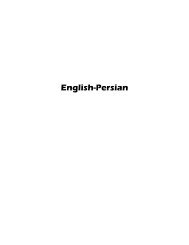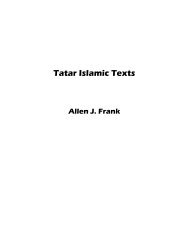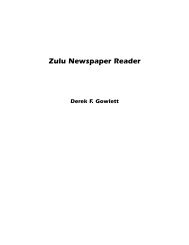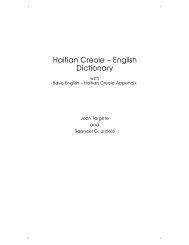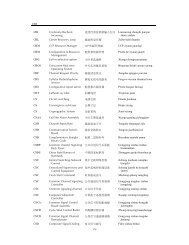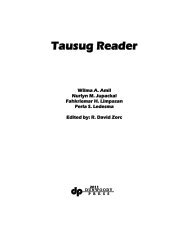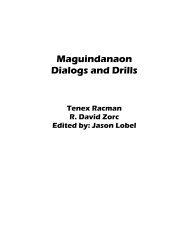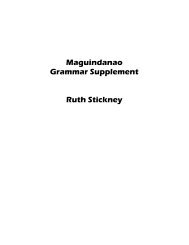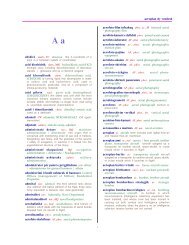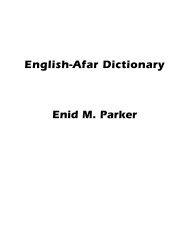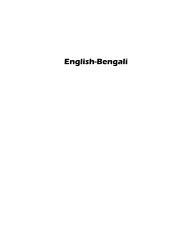Akan Newspaper Reader - Dunwoody Press
Akan Newspaper Reader - Dunwoody Press
Akan Newspaper Reader - Dunwoody Press
Create successful ePaper yourself
Turn your PDF publications into a flip-book with our unique Google optimized e-Paper software.
<strong>Akan</strong> <strong>Newspaper</strong><br />
<strong>Reader</strong><br />
Samuel Gyasi Obeng
<strong>Akan</strong> <strong>Newspaper</strong><br />
<strong>Reader</strong><br />
Samuel Gyasi Obeng<br />
2008
<strong>Akan</strong> <strong>Newspaper</strong> <strong>Reader</strong><br />
Copyright © 2008 by McNeil Technologies, Inc.<br />
All rights reserved.<br />
No part of this work may be reproduced or transmitted in any form or by<br />
any means, electronic or mechanical, including photocopying and<br />
recording, or by any information storage and retrieval system, without the<br />
prior written permission from the copyright owner.<br />
All inquiries should be directed to:<br />
<strong>Dunwoody</strong> <strong>Press</strong><br />
6525 Belcrest Rd., Suite 460<br />
Hyattsville, MD 20782, U.S.A.<br />
ISBN: 978-1-931546-52-2<br />
Library of Congress Control Number: 2008941271<br />
Printed and bound in the United States of America
Table of Contents<br />
Acknowledgements ......................................................................................i<br />
Introduction: <strong>Akan</strong> Culture and Language<br />
<strong>Akan</strong> Culture ................................................................................................ iii<br />
The People.................................................................................................... iii<br />
Personhood................................................................................................... iv<br />
Marriage....................................................................................................... iv<br />
Inheritance..................................................................................................... v<br />
Rites of Passage ............................................................................................. v<br />
Religion & the Concept of God....................................................................... v<br />
Political Organization.................................................................................... vi<br />
Social Interaction .......................................................................................... vi<br />
<strong>Akan</strong> Language ............................................................................................viii<br />
Orthography.................................................................................................. ix<br />
Phonology ..................................................................................................... x<br />
Tone............................................................................................................ xv<br />
Grammatical Sketch ....................................................................................xvii<br />
References.................................................................................................. xxiii<br />
Other Important Sources ..............................................................................xxiv<br />
Selections<br />
1. AyibOne...................................................................................................1<br />
2. Nkran Kuro Dada No, YEbEsiesie HO .....................................................2<br />
3. Kwan A <strong>Akan</strong>foO Fa So Bu MmerE ........................................................3<br />
4. YEn KwaeE Ho Dwumadie......................................................................5<br />
5. Oman AhyEnsoO Krataa...........................................................................7<br />
6. EnnsE SE Ghanaman Hwere Ne Kra .......................................................9<br />
7. AwerEhyEm A GhanafoO A WOwO AmannOne Anya.............................11<br />
8. Sika Nti Anaa?......................................................................................13<br />
9. Aman A WoyE YEn AdoeE A YEde YEn Ho Ato WOn So No<br />
Emmoa YEn ..........................................................................................16<br />
10. AdwenemuteE Firi ApOmuden Mu .........................................................19<br />
11. YEn Ne Aman A Atwa YEn Ho Ahyia Ntam AyOnkofa ........................22<br />
12. BO Wo Ho Ban Firi AkorOmfo WerEmfoO Ho .......................................25<br />
13. Eka A YErebO Atua Ni?........................................................................28<br />
14. OnyankopOn AkyE YEn AdeE................................................................31<br />
15. Oman A WOwO ApOmuden No, WOwO Sika..........................................35<br />
16. Nnipa Bi ReyE Apa Aba .......................................................................37<br />
17. AnansesEm Ho MfasoO..........................................................................40<br />
18. Dagbon AtoyerEnkyEm No ....................................................................43<br />
19. Nkyea Ne Akwaaba Ma........................................................................47<br />
20. Obi Nnim A Obi KyerE .........................................................................52
21. Oman Yi Gyina Akono..........................................................................55<br />
22. YEhia GhanafoO Nyinaa Mmoa.............................................................60<br />
23. SEbe Bagyimi-BerE No, Atwam! ...........................................................63<br />
24. Nsuo Ho MfasoO....................................................................................66<br />
25. Ntam .....................................................................................................69<br />
26. Emu AyE Den Nanso, AnidasoO WO HO! ..............................................73<br />
27. Ohaw A Oman Yi Wo Mu No, Emmfiri ApaeE Anaa Nsaguo...............76<br />
28. <strong>Akan</strong>foO AsEnnie...................................................................................79<br />
29. YEwO NsEm BO NO PO!.........................................................................82<br />
30. Polisi Adwuma Yi! .................................................................................84<br />
31. YErehwE DeE EbEsie! ...........................................................................88<br />
32. Abaatan DeE Nie ..................................................................................91<br />
33. Amoma (NsEm A WOka De Hoahoa Ahenfo) ........................................95<br />
Translations<br />
1. Haircut (Proverb)............................................................................... 103<br />
2. Old Accra to Be Regenerated........................................................... 103<br />
3. How the <strong>Akan</strong> Tell Time.................................................................... 103<br />
4. Our Foestry Program ........................................................................ 103<br />
5. National Identity Card....................................................................... 104<br />
6. Ghana Must Not Lose Her Soul........................................................ 104<br />
7. Confidence of Ghanaians Abroad.................................................... 104<br />
8. Is It Because of Money? .................................................................... 104<br />
9. Unhealthy Dependence on Donors................................................. 105<br />
10. A Healthy Mind Comes from a Healthy Body.................................. 105<br />
11. Good Neighborliness........................................................................ 106<br />
12. Protect Yourself from Armed Robbers.............................................. 106<br />
13. Is This the Kind of Debt We Want to Incur? .................................... 107<br />
14. God Has Given Us a Gift (of Language) .......................................... 108<br />
15. A Healthy Nation Makes a Wealthy Nation ..................................... 109<br />
16. Some People Are Giving up.............................................................. 109<br />
17. Importance of Folk Tales................................................................... 110<br />
18. The Dagbon Tragedy........................................................................ 111<br />
19. Greetings and Welcoming................................................................ 112<br />
20. If One Does Not Know, Another Teaches (Him/Her)...................... 113<br />
21. The Nation Is at War (Is on the Battlefront)..................................... 113<br />
22. Support Needed from All Ghanaians............................................... 114<br />
23. Apologies, the Time of Ignorance Is Gone! ..................................... 115<br />
24. The Importance of Water.................................................................. 116<br />
25. Oath-Taking....................................................................................... 116<br />
26. It Is Tough, but There Is Hope.......................................................... 118<br />
27. The Problems We Are Facing as a Country ..................................... 118<br />
28. <strong>Akan</strong> Native Courts ........................................................................... 119<br />
29. We Have a Lot on Our Hands!......................................................... 120<br />
30. This Police Job!.................................................................................. 120<br />
31. We'll See What Will Happen............................................................. 121<br />
32. This Is for Women Who Are Raising Children.................................. 122<br />
33. Praise Poetry (Words Used to Prase a King)..................................... 123<br />
Glossary...................................................................................................... 129
Acknowledgements<br />
The linkage between Indiana University’s Program in African Languages<br />
and Linguistics and the African Language Research Project of the<br />
University of Maryland, Eastern Shore (UMES), formed the bedrock out of<br />
which the <strong>Akan</strong> <strong>Newspaper</strong> <strong>Reader</strong> grew. During the research leading to<br />
the production of this reader, I paid particular attention to UMES’s aim of<br />
facilitating and improving upon the study of African languages through the<br />
use of real instead of imagined texts.<br />
I would like to thank Mr. Nii Noi Vanderpuye, editor of The Heritage also<br />
called The Weekend Heritage, and The Heritage AkwansosEm, who gave<br />
permission for the use of texts from his newspaper. Without his consent,<br />
this project would have failed. I am also thankful to the other members of<br />
The Heritage’s editorial board, especially Mr. Stephen Owusu, Dr. Gordon<br />
Adika, and Mr. Cofie Ammuako-Annan, and to Mr. Kofi Frempong Barfi,<br />
the columnist whose sharp thinking and crisp writing attracted my attention<br />
to The Heritage newspaper.<br />
I would also want to thank Dr. Seth Ofori (Department of African<br />
Languages and Literatures, University of Wisconsin, Madison), Dr. Tristan<br />
Purvis (Assistant Editor, Issues in Intercultural Communication), and Dr.<br />
David Zorc, Senior Linguist of the Language Research Center, McNeil<br />
Technologies, for helping in various ways. Finally, I would like to express<br />
my sincerest appreciation to Professor Chester M. Hedgepeth, Director of<br />
the UMES African Languages Project, for his encouragement and immense<br />
support. Other people at Professor Hedgepeth’s center also assisted me in a<br />
number of ways. Here I would like to acknowledge with thanks the help of<br />
the following people; Mr. Magdi Elobeid, Dr. Robert Hardy, and Ms.<br />
Terrell Sharone.<br />
i
Introduction: <strong>Akan</strong> Culture and Language<br />
<strong>Akan</strong> Culture<br />
The People<br />
The <strong>Akan</strong> people trace their ancestry to Ancient Ghana and the Oasis of<br />
Djado. They inhabit most of the forest areas of the southern and middle<br />
belts of Ghana and southeastern La Côte d’Ivoire in West Africa. Agona,<br />
Ahanta, Akwamu, Akuapem, Akyem, Asante, Brong, Dankyira, Evalue,<br />
Fante, Awutu, Efutu, Anum Gomua, Kwawu, Nzema, Sefwi, Wassa, and<br />
other minor groups constitute the ethnic <strong>Akan</strong> group. Traditionally, the<br />
largest and most powerful ethnic groups within the <strong>Akan</strong> group are the<br />
Asante, the Fante, and the Akyem.<br />
To a great extent, the <strong>Akan</strong> share a common culture, parts of which they<br />
share with the other ethnic groups of West Africa and other parts which<br />
distinguish them from the other ethnic groups in West Africa. The most<br />
important cultural aspects unique to the <strong>Akan</strong> peoples are: a common fortytwo-day<br />
calendar, their concept of God, political organization, marriage<br />
systems, and a matrilineal system of inheritance (Obeng, 2003).<br />
In <strong>Akan</strong> society, there are nine forty-two-day units in the annual calendar.<br />
Unlike Western societies where a year is made up of 365 or 366 days, the<br />
<strong>Akan</strong> year or annual calendar is made up of 378 days. The forty-second day<br />
of each forty-two day unit is considered a holy day. People born on such<br />
days are given special names such as Adae and Fodwo, among others, to<br />
mark the day.<br />
Obeng (2001) notes that there are six holy days that form the basis of the<br />
<strong>Akan</strong> calendar: Kuru “exactness”; Kwa “emptiness”; Mono “new, fresh”;<br />
Fo “love, satisfaction, restfulness”; Ngona “good living, good governance”;<br />
and Nkye “passing by.” The holy days can fall on any day of the week.<br />
Thus, there can be K uru-Kwasie “Exactness Sunday”; Kwa-Kwasie<br />
“Empty Sunday”; and FO-DwoO “Love/Satisfaction/Restfulness Monday,”<br />
among others.<br />
On <strong>Akan</strong> anthroponymy, Obeng (2001) notes that every <strong>Akan</strong> has a dayname<br />
referred to as their kra-din ‘soul-name.’ The day on which one was<br />
born is called kra-da ‘soul-day’ and throughout one’s life it is a day on<br />
which one’s soul rejoices, is cautious, and can be pacified or even cursed.<br />
In the past, a person who died on his soul-day was believed never to be able<br />
to reincarnate. Every attempt was therefore made to prevent sick people<br />
from dying on their soul-days. On some occasions, for example if a<br />
Monday-born died on a Monday, the death was concealed and announced<br />
the following day to prevent people from associating the death with<br />
mystery. Except for Yaw (Thursday-born), all the male <strong>Akan</strong> day-names<br />
iii
are derived from the holy day Kwa ‘emptiness’ and on gods associated with<br />
each day. Table 1 below shows <strong>Akan</strong> day names.<br />
Table 1. <strong>Akan</strong> Day Names<br />
<strong>Akan</strong> Days English Gloss Male Name Female<br />
Name<br />
iv<br />
<strong>Akan</strong> God<br />
Kwasiada Sunday Kwasi Akosua Awusi<br />
Dwoada Monday Kwadwo Adwoa Adwo<br />
Benada Tuesday Kwabena Abenaa Bena<br />
Wukuada Wednesday Kwaku Akua Aku<br />
Yawoada Thursday Yaw Yaa/Aba Yaw<br />
Fiada Friday Kofi Afia Afi<br />
Memeneda Saturday Kwame Ama Amen<br />
Personhood<br />
<strong>Akan</strong> society is viewed as collectivist, described by the phrase “people are<br />
because the society is.” Individuals are situated in the society and exist only<br />
because the society exists. From a social theoretic point of view,<br />
collectivism supersedes individualism. An individual is made up of three<br />
entities: honam/mogya ‘the body’/‘blood,’ Okra ‘the soul,’ and<br />
sunsum/homhom ‘the spirit.’ An individual’s body is connected with one’s<br />
mother, the soul with the father, and the spirit with God and the ancestors.<br />
These three entities are equally important in an individual’s life and<br />
sickness could be triggered by and/or targeted at any or all of the entities.<br />
<strong>Akan</strong> medical practice is thus holistic (Obeng, 2003). All three entities,<br />
body, soul, and spirit, are treated.<br />
Marriage<br />
Marriage and courtship in <strong>Akan</strong> society may or may not be arranged.<br />
Whether they are arranged or not, marriage is considered a union between<br />
the bride’s and the groom’s extended families, not just between the bride<br />
and the groom. A woman does not take her husband’s name but maintains<br />
her own (maiden) name. Also, women maintain their own property and<br />
strive toward financial independence. The proverb Obarima nyE sumyE na<br />
Obaa de ne ti asum no ‘A man is not a pillow upon which a woman must<br />
rest her head’ illustrates the above claim (Obeng, 2003). Besides proverbs<br />
and aphorisms, there are songs in the language that caution women against<br />
financial dependency on men. A woman who relies solely on the generosity<br />
of her husband, hoping that after his death the jointly acquired property will<br />
be hers, may realize that her services were in vain. Such fruitless labor is
eferred to as kEntEn hunu soa ‘carrying empty basket,’ that is, ‘laboring in<br />
vain.’<br />
Children born in a marriage belong to the woman’s abusua ‘blood lineage’<br />
and the father’s ntOn ‘spirit-lineage.’ The relationship with one’s father is<br />
via the father’s spirit and children adopt their father’s taboos (including<br />
food, oaths, religious affiliations).<br />
Polygamy is allowed but must, in theory, be backed by sound financial<br />
standing and appropriate compensation for the first wife or wives. Divorce<br />
is permitted and occurs after counselling by elders has failed. Divorce may<br />
be caused by adultery (traditionally on the part of the woman, but these<br />
days also on the part of the husband), domestic violence, impotence,<br />
barrenness, disrespect toward the in-laws, criminal conduct, and financial<br />
crises, among other reasons. An incomplete and/or half-hearted<br />
performance of the rites of marriage may also result in the annulment of a<br />
marriage because it is a sign of lack of love and respect for the woman.<br />
Inheritance<br />
A matrilineal system of inheritance is followed. Children have the right to<br />
inherit their maternal uncles’ or aunts’ property, but not their father’s or<br />
paternal uncles’ and aunts’ properties. Fathers may, however, give part of<br />
their property to their children during their lifetimes. A father who leaves<br />
no property for his children is labeled kwaseampani ‘good-for-nothing’ or<br />
ObofoO ‘mean and uncaring.’ In modern <strong>Akan</strong> society, there are laws<br />
(intestate succession laws) that directly contradict traditional laws on<br />
succession. This has been the source of many instances of litigation.<br />
Rites of Passage<br />
Rites on birth, puberty, and death are highly cherished and religiously<br />
performed. Life is celebrated in death, given the society’s belief in the<br />
afterlife and the role the ancestors play in the daily lives of the living.<br />
Belief in reincarnation, the punishment of the wicked, and the disgrace that<br />
faces the ill-behaved act as social control measures for the living and<br />
prohibit acts considered antisocial and/or anti-cultural.<br />
Religion & the Concept of God<br />
The <strong>Akan</strong> believe in God’s existence via the maxim Obi nkyerE akwadaa<br />
Nyame ‘No one tells/teaches the child about God’s existence.’ In other<br />
words, even children know that God exists. God is known by names<br />
connected to his many attributes: Amansu ‘Giver of water,’ Amaowia<br />
‘Giver of sun,’ Ototrobonsu ‘The Big whale,’ Onyankopon ‘Big friend,’<br />
Onyame ‘Satisfying,’ Mframa ‘Wind,’ Ahuabobrim ‘Fearsome,’ and<br />
Twereduampon ‘Lean-on-a-tree-do-not-fall,’ or ‘Dependable.’ God is also<br />
called Ananse-Kokroko ‘the Big-Spider,’ for, like a spider, God is capable<br />
v
of tasks and acts not easily understood by an ordinary mortal. He is to be<br />
feared and revered.<br />
God is viewed as male but possesses feminine or motherly characteristics.<br />
His name, Kwame, suggests he is seen as a male person born on Saturday;<br />
however, he viewed as Baatan pa ‘Excellent Mother.’ His son, Kwaku<br />
Ananse (the <strong>Akan</strong> folk hero), manifests humanity’s many emotional<br />
characteristics (love, hate, hope) and weaknesses(greed, murder, slander,<br />
and lying). Seen as a trickster in <strong>Akan</strong> philosophy and folklore, Kwaku<br />
Ananse embodies humanity’s successes and failures. Through Kwaku<br />
Ananse, God imparts all forms of knowledge to the people. It was Ananse<br />
who taught the people how to weave the traditional costume, the kente<br />
cloth. He also educated and continues to educate the people about how to<br />
engage in a just and/or an impartial arbitration, punish the wicked, and<br />
reward the just.<br />
Besides the <strong>Akan</strong> traditional religion (Ancestral Worship), Islam,<br />
Christianity, and other religions are also practiced by the <strong>Akan</strong>. It is also<br />
common to see people practice more than one religion.<br />
Political Organization<br />
Each town is governed by a male and a female chief in conjunction with<br />
appointed elders and a war group headed by war-chiefs. The masses<br />
contribute to the running of the community through their sub-leaders, and<br />
at public fora and special festivals they are able to voice their views in an<br />
uninhibited manner. On most occasions, although speech is free (because<br />
the Big Spider, God, did not sell it but gave it freely), specific restrictions<br />
are placed on certain kinds of speech and sanctions are imposed on<br />
improper verbalization of taboo words and expressions.<br />
Social Interaction<br />
The <strong>Akan</strong>, like most other peoples, place a high premium on pragmatic<br />
competence in all communicative situations. Obeng (1999) notes that in<br />
ordinary conversations among equals, any speaker who overly dominates<br />
the floor may be shunned. It is common to hear people say of such a person<br />
Okasa a, Omma obi nka bi ‘When he speaks, he does not give others the<br />
chance to also speak.’ An interactant who persistently interrupts others may<br />
be reprimanded in public, which acts as a deterrent to others. If a person<br />
exhibits such behavior before the elders, he or she may be labeled Gyae<br />
ma menka ‘Stop-so-that-I’ll-speak;’ that is, a ‘know-it-all.’ Such behavior,<br />
if not checked, may result in the exclusion of the person from formal or<br />
semi-formal interactional situations. Self-correction and especially<br />
correcton of others’ speech is greatly valued as seen in the <strong>Akan</strong> adage Obi<br />
nnim a, obi kyerE ‘If someone does not know, another should teach<br />
him/her.’ However, if one makes it a habit to either initiate or undertake<br />
correction of others, one may be labeled boastful or a know-it-all.<br />
vi
Politeness and indirectness are two of the most important discursive<br />
phenomena in <strong>Akan</strong> social interaction. The spoken word is perceived as<br />
having the power to make or break an individual, so politeness, avoidance,<br />
and various forms of indirectness are employed to mitigate inherent risks in<br />
the art of speaking. Studies on politeness such as those done by Brown and<br />
Levinson (1978: 21ff.); Leech (1983: 145); Nwoye (1989); Obeng (1996,<br />
1997b, 1999a, 1999d, 2003) and Yankah (1995) have all noted the role that<br />
indirectness plays in polite behavior crossculturally. Leech (1983), for<br />
example, discusses the use of euphemism, hyperbole, and other figures of<br />
speech as politeness strategies. As in other cultures such as the Zulu (see de<br />
Kadt, 1998), in <strong>Akan</strong> culture, politeness plays a significant role in facework.<br />
In <strong>Akan</strong> society, an expression or utterance is said to be polite if, in<br />
the words of Yankah (1995: 54), it is “suffused with terms of politeness or<br />
courteous addressives.” Politeness is socially prescribed and polite speech<br />
is used to express either solidarity or deference. In formal speech, a stylistic<br />
marker of politeness is for one's speech to be suffused with apologetic<br />
formulae and disclaimers. Such apologetic formulae are used to warn other<br />
interactants of an imminent (apparent or real) profanity, verbal taboo, or<br />
proverb, as well as to disclaim “any possible impression of irrelevant or<br />
offensive intent in the use of language” (cf. Yankah, 1995: 56)). Terms of<br />
respect may be suffixed to requests, to expressions of thanks or gratitude,<br />
as well as to greetings, in order to signal politeness. Such polite addressives<br />
soften the face-effect of a locution. For example, the expression Fa ma me,<br />
aberaw ‘Give it to me with due respect to your social class’ is a polite<br />
request (Yankah, 1995:56). Obeng (1999a) calls for <strong>Akan</strong> politeness to be<br />
looked at from the point of view of the interactional participants, their<br />
immediate social groups, and the entire <strong>Akan</strong> ethnic group.<br />
In <strong>Akan</strong> culture, polite speech finds expression in the use of apologetic<br />
expressions and, more especially, through various indirection strategies,<br />
such as proverbs, euphemisms, metaphors, and other figurative expressions.<br />
Where one cannot help but be direct, an apologetic expression like sEbe<br />
‘excuse me, please’ or mesrE meka ‘I beg to say’ is used as a preface to<br />
non-euphemistic talk about taboo topics (Obeng, 1994). Obeng identified<br />
proverbs, metaphors, innuendoes, euphemisms, circumlocution (which<br />
involves skirting the topic of the discourse and therefore diverting attention<br />
to other issues), riddles, tales, and hyperboles as some of the strategies<br />
through which verbal indirection, and hence politeness, finds expression. In<br />
<strong>Akan</strong>, off-record indirectness such as circumlocution are regarded as an<br />
acceptable communicative strategy, especially when the subject matter of<br />
the interaction is considered face-threatening. It is, for example, impolite to<br />
ask for a favor (in kind or cash) directly. Such requests have to be done<br />
indirectly through circumlocution since an offer is preferable to a request<br />
and because, more importantly, a refusal could lead to face loss on the part<br />
of the requester and/or requestee.<br />
vii
Other verbal indirection strategies include triadic communication involving<br />
the use of intermediaries. Here, face-threatening messages are routed<br />
through proxies and pseudo-addressees like orators, dogs (Obeng, 1999c),<br />
and children, among others (Obeng, 1995; Schottman, 1995; Yankah,<br />
1995). Evasion, a communicational strategy in which a speaker, in<br />
answering a question, ignores the unknown variable presupposed by the<br />
question, is also an indirect strategy. Other strategies include innuendoes<br />
(which require the target referent to be aware of its subliminal frame of<br />
interpretation—i.e., its pragmatic import), pronoun mismatching (Obeng,<br />
1997c), onomasiology (through anthroponymy, toponymy and autonymy<br />
(Obeng, 2000b, 2001, 2002)), and graffiti (Obeng 2000a).<br />
Verbal indirection is also employed to embellish speakers’ utterances, to<br />
draw other interactants' attention to relevant issues, to persuade them, to<br />
minimize social and/or communicational tension, and to settle personal<br />
scores. Properly managed indirectness provides the interlocutors with<br />
several benefits including defense and rapport (Tannen, 1996). Indirection<br />
plays a significant role in conversational management as well as in the<br />
maintenance of face and in politeness.<br />
<strong>Akan</strong> Language<br />
<strong>Akan</strong>, also called Twi-Fante, belongs to the Tano group of languages of the<br />
Central Comoe branch, a sub-division of the Kwa sub-group that belongs to<br />
the Niger-Congo language family. Related languages include Anyi<br />
(Aowin), Sehwi, Nzema, Ahanta, Efutu/Awutu, Anum, Kyerepong, and<br />
Larteh. <strong>Akan</strong> has over 10 million speakers.<br />
It must be made clear at this juncture that not all the minor ethnic groups<br />
listed under the “<strong>Akan</strong> people” speak an <strong>Akan</strong> language. The Nzema, for<br />
example, speak Nzema, and the Awutu, Efutu, and Anum speak Guang,<br />
which is not an <strong>Akan</strong> language. Dolphyne’s (1965; 1988) view that<br />
speakers of <strong>Akan</strong> dialects are only a subgroup of the <strong>Akan</strong> people is<br />
correct.<br />
Of all the dialects of the <strong>Akan</strong> language, only Akwapim, Asante/Akyem,<br />
and Fante have achieved literary status. Each of the three major dialects has<br />
a written form that reflects its peculiarities so that it is not easy for an<br />
Asante speaker to read a text in Fante and vice-versa (Dolphyne, 1988: 20;<br />
Obeng, 1997a). A unified standard orthography has been devised by the<br />
Language Teaching Center, the Linguistics Department (University of<br />
Ghana), and the Bureau of Ghanaian Languages under the auspices of the<br />
<strong>Akan</strong> Language Committee.<br />
Minor linguistic differences (such as palatalization and labialization, quite<br />
predominant in Fante) differentiate these dialects. Vocalic length<br />
differences and a few lexical differences also occur in some of the dialects<br />
(Schachter & Fromkin, 1968; Dolphyne, 1988). However, these dialects<br />
could be said to be mutually intelligible in their spoken modes.<br />
viii
The name <strong>Akan</strong> as used in this newsreader is thus just a general label<br />
representing all the dialects mentioned above. This means that unlike RP<br />
English (a variant of Standard English) that is purported to be spoken by<br />
some British people, Standard <strong>Akan</strong> is not spoken by anybody (Obeng,<br />
1997a). The dialects of <strong>Akan</strong> are the spoken language.<br />
Orthography<br />
Three orthographies (Akuapem, Asante and Fante) exist in <strong>Akan</strong>. In this<br />
reader, the Asante orthography is used. The orthographic notations are: a b<br />
d e E f g h i k l m n o O p r s t u w y. Some of the vowel alphabets have<br />
two pronunciations. Besides the above symbols, there are the following<br />
diagraphs: hy, hw, tw, dw, ng, ny, nw, ky, gy, and mw. Table 2 below<br />
shows the orthographic notations, close pronunciation guide, and example<br />
words in English and <strong>Akan</strong>.<br />
Orthographic<br />
Symbol<br />
Pronunciation:<br />
Phonetic / Rough<br />
Guide<br />
[a]<br />
[œ]<br />
English Word (or<br />
sound sequence)<br />
ix<br />
Example in <strong>Akan</strong><br />
a<br />
father<br />
fa ‘take’<br />
a<br />
man<br />
ani ‘eye’<br />
b [b] bee bra ‘come’<br />
d<br />
[d]<br />
day<br />
da ‘sleep’<br />
dw<br />
[dÛÁ] / [dZw],<br />
‘jw’<br />
[jw]<br />
dware ‘bathe’<br />
e<br />
[e]<br />
day<br />
efie ‘home’<br />
e<br />
[I]<br />
bit<br />
se ‘sharpen’<br />
E [E] head Edan ‘house’<br />
f [f] fee fa ‘take’<br />
g<br />
[g]<br />
go<br />
gu ‘to broadcast<br />
gy<br />
[dÛ] / [dZ], ‘j’ judge<br />
(seeds)’<br />
gyae ‘stop’<br />
h [h] he Eha ‘here’<br />
hw [ÇÁ] / [hw],<br />
‘shw’<br />
hw hwE ‘look’<br />
hy [Ç] / [S], ‘sh’ shirt hyE ‘wear’<br />
i [i] beat si ‘wash’<br />
k [k] key Eka ‘debt<br />
kw [kw] quick Kwasi (proper<br />
name)<br />
ky [tÇ] / [tS] church kyE ‘share’<br />
l [l] lady lore ‘vehicle’<br />
m [m] meat ma ‘give’<br />
mw [mw] mw- mwia<br />
/mia‘squeeze’<br />
n [n] no nim ‘know’
ng [N] / ‘ng’ singer maangoo ‘mango’<br />
nw [nÁ] / [w], nyw- nwiinwii<br />
‘nyw’<br />
‘hesitate’<br />
ny [] / ‘ny’ onion Onyame ‘God’<br />
o<br />
[o]<br />
doe<br />
owuo ‘death’<br />
o<br />
[U]<br />
foot<br />
fo ‘climb’<br />
O [O] more dO ‘love’<br />
p [p] pay papa ‘good’<br />
r [r] read bra ‘come’<br />
s [s] see sa ‘dance’<br />
sw [sw] sweat soE [swIE] ‘carry’<br />
t [t] tea tu ‘uproot’<br />
tw [tÇÁ] / [tSw], chew Twi (name of<br />
‘chw’<br />
<strong>Akan</strong> dialect)<br />
u [u] to wu ‘die’<br />
w [Á] / [w] we ware ‘marry’<br />
y [y] yes yadeE ‘disease’<br />
Only [m] (all the dialects), [N] (Ak), [n] (Fa), and [r] (Fa) occur in wordfinal<br />
positions in the dialects in parenthesis. There are no voiced fricatives<br />
in <strong>Akan</strong>. Only plosives and affricates have voiced and voiceless<br />
counterparts. The velar, glottal, pre-palatal, and palatal consonants have<br />
labialized and non-labialized counterparts. All nasals, trills, laterals, and<br />
approximants are voiced. No verb, noun, or adjective stem begins with [r]<br />
or [N]. Only Fante has prenasalized consonant sequences.<br />
Other Dialects Fante<br />
[mm] [mb]<br />
[nn] [nd]<br />
[] [dÛ]<br />
[NN] [Ng]<br />
Other Dialects Fante English<br />
[mmofra] [mbofra]children<br />
[nna] [nda] don’t sleep<br />
[a] [dÛa] don’t leave behind<br />
[NNU] [NgU] palm oil<br />
Phonology<br />
Sound System<br />
Vowel sounds<br />
<strong>Akan</strong> has ten vowel sounds described below.<br />
[i] Unrounded, high, advanced, front vowel.<br />
x
[I] Unrounded, between high and mid, unadvanced, front vowel.<br />
[e] Unrounded, mid, advanced, front vowel.<br />
[E] Unrounded, mid, unadvanced, front vowel.<br />
[œ] Unrounded, between mid and low advanced central vowel.<br />
[a] Unrounded, low, unadvanced, central vowel.<br />
[O] Rounded mid, unadvanced, back vowel.<br />
[o] Rounded, mid, unadvanced, back vowel.<br />
[U] Rounded, between mid and high, unadvanced, back vowel.<br />
[u] Rounded, high, advanced, back vowel.<br />
Advanced vowels are produced with the root of the tongue pushed high up<br />
in the mouth. Unadvanced vowels are produced with a retracted tongue root<br />
position. These vowels occur in words such as:<br />
si [si] wash<br />
se [sI] sharpen<br />
esie [esie] a hill<br />
sE [sE] resemble<br />
kari [kœri] weigh<br />
sika [sikœ] money (Gomua, Fante)<br />
sa [sa] dance (v.)<br />
sO [sO] join<br />
so<br />
dialect)<br />
[so] (question particle found only in the Akuapem<br />
so [sU] on top of, to bear fruit<br />
su [su] go bad (usually of cocoyam)<br />
Apart from [œ], all the vowels are contrastive and are hence different<br />
phonemes. [œ] is an allophone of [a] that occurs before [i] and [u]. For<br />
example, daabi [dææbi] ‘no’ and patu [pætu] ‘pretend.’<br />
Nasalization is also phonemic in <strong>Akan</strong>. <strong>Akan</strong> phonemic nasalized vowels<br />
are [ i& ], [ I& ],<br />
[ a& ], [ U& ], and [ u& ]<br />
fi [fi] go out<br />
fi [fi&] dirt<br />
se [sI] sharpen<br />
se [sI&] teeth<br />
fa [fa] take<br />
fa [fa‡] half<br />
so [sU] bear fruit<br />
so [sU‡] be big<br />
ku [ku] scrape or pluck fur from an animal<br />
ku [ku‡] kill<br />
xi
In <strong>Akan</strong>, all front and central vowels are produced with unrounded lips,<br />
whereas all back vowels are produced with rounded lips. The high and low<br />
vowels have oral and nasalised counterparts, whereas all the mid vowels<br />
are oral.<br />
The vowels [E], [e], [œ], [a], [o], and [O] may occur as word-initial vowels<br />
in the Akuapem and Asante dialects (Dolphyne, 1988), including Edan<br />
‘house,’ esie ‘hill,’ ani [œni] ‘eye,’ aso [asU] ‘ear,’ owuo ‘death,’ OwO<br />
‘snake.’ In Asante, [e] or [E] are placed before a word whose root begins<br />
with a nasal consonant, such as Empa ‘bed.’ The vowels [i], [I], [E], [e],<br />
[a], [o], and [O] occur as word-initial vowels in Fante. Apart from [œ], all<br />
vowels can occur in syllable final as well as word-final positions in all the<br />
dialects. An exception to the above rule is found in Gomua where [œ]<br />
occurs in word-final position of few words like sika [sikœ] ‘money.’<br />
Consonant Sounds<br />
Plosives: The plosive sounds in <strong>Akan</strong> are: [p], [b], [t], [d], [k], [kw], [g],<br />
and [gw]. These sounds occur in words like papa ‘goodness,’ bra ‘come,’<br />
tu ‘fly,’ da ‘sleep,’ ka ‘bite,’ kwa ‘just,’ gidigidi ‘tussle,’ and gware<br />
‘bathe.’<br />
Affricates: <strong>Akan</strong> has six affricate sounds. These plosives/sounds are stops<br />
produced with audible friction. The <strong>Akan</strong> affricates are ts [ts], dz [dz], ky<br />
[tÇ], gy [dÛ], tw [tÇÁ], and dw [dÛÁ]. [ts] and [dz] occur in Fante words like<br />
tsew ‘to pluck’ and dzi ‘to eat.’ [dÛ], [tÇÁ], and [dÛÁ] occur in words such<br />
as gye [dÛI] ‘to receive,’ Twi [tÇÁi] (name of several <strong>Akan</strong> dialects), and<br />
dwen [dÛÁIn] ‘to think.’ [tÇÁ] occurs before front and back vowels and is,<br />
on the whole, in complementary distribution with the labialized back<br />
consonants [kw], [gu], and [hu], which occur only before [a].<br />
Fricatives: The fricatives in <strong>Akan</strong> are all voiceless. They include f [f], s [s],<br />
sw [sw], hy [Ç], hw [ÇÁ], and h [h]: fa ‘take,’ si ‘alight,’ sane [sianI]<br />
‘untie,’ sweE ‘bring down load from one’s head or someone else’s head,’<br />
hyE [ÇE] ‘wear,’ hwE [ÇÁE] ‘look,’ ho [hU] ‘smoke (fish/animal),’ and hwa<br />
‘to burn the fur of an animal.’<br />
Nasals: The nasals in <strong>Akan</strong> are [m], [n], [], [Á], [N], and [Nw]. [m]<br />
occurs in a word like ma ‘give,’ [n] in nana ‘grandparent,’ [] in nyame<br />
[amI] ‘god,’ [Á] in nwono ‘weave,’ [N] in ngo [NNU] ‘palm oil,’ and [Nw]<br />
in Enwa [ENwa] ‘snail.’<br />
Approximants: The approximants in <strong>Akan</strong> are [w] as in ware [warI]<br />
‘marry,’ [Á] as in we [ÁI] ‘chew,’ and [j] as in yE [jE] ‘make.’<br />
Trill: The alveolar trill, [r], occurs in words such as abofra [abofra] ‘child’<br />
and Okra [Okra] ‘cat.’ The alveolar trill can be substituted with the alveolar<br />
lateral [l]. Thus, instead of saying [abofra] one can say [abofla]<br />
xii
In Akuapem and Asante, labial and alveolar consonants occur before all<br />
vowels (front, central, back). In Fante, [b] and [p] are palatalized before<br />
front vowels as in pE [pE] ‘to like’ and bEn [bEn] ‘to be near.’ Moreover,<br />
before front vowels, [ts] replaces [t] and [dz] replaces [d]. [t] and [d] occur<br />
only before back vowels and the central vowel [a]. [n] does not occur<br />
before front vowels in Fante.<br />
The non-labialized palatal consonants [Ç] and [tÇ] occur mainly before<br />
front vowels. They are in complementary distribution (they occur in<br />
different phonetic environments) with non-labialized back consonants<br />
(velar and glottal consonants) [k], [g], [N], and [h], which occur mainly<br />
before back vowels and [a]. All consonants, except [r] and [N], occur in the<br />
stem-initial position. Nasals occur before other consonants, where they are<br />
homorganic with the following consonant (i.e., they have the same place of<br />
articulation as the following consonant). The semivowels [j] and [w] occur<br />
before oral vowels only.<br />
Syllable Structure<br />
Tone plays a significant role in syllabification because every syllable<br />
carries its own tone.<br />
<strong>Akan</strong> has three main syllable types: C, V, and CV. The syllabic consonant<br />
is mostly syllabic nasal and carries its own tone, for example, nkwa [NŸ-kWa!]<br />
‘life,’ mpa [mŸ-pa!] ‘bed,’ pam [pa!-m!] ‘sew.’ The CV syllable type is by far<br />
the most common syllable structure in <strong>Akan</strong>. Examples of words with CV<br />
structure are fa ‘take,’ sa ‘dance,’ ware [waŸrIŸ] [waŸ-rIŸ] ‘get married.’ The V<br />
syllable structure, like C, has its own tone. It may occur in isolation or in<br />
combination with other sounds for example, a ‘who, which, where,’ tie<br />
[tiŸeŸ][ti - e] ‘to listen,’ and kae [kaŸIŸ] [ka-ŸI] ‘to remember.’<br />
Vowel Harmony<br />
Vowel harmony (VH) is a type of assimilation which takes place when<br />
vowels of a particular class share certain features with other vowels of the<br />
same class elsewhere in a word or phrase. <strong>Akan</strong> has ATR/+ATR harmony<br />
and /+round harmony. In a ATR/+ATR harmony situation, the sounds<br />
may or may not be contiguous, but they are often in the same word. For<br />
example, a +ATR vowel in a second syllable may require a +ATR vowel in<br />
the first syllable. <strong>Akan</strong> vowels fall into two groups:: +ATR and ATR.<br />
+ATR vowels are [i], [e], [œ], [o], and [u], and ATR vowels are [I], [E],<br />
[a], [O], and [U]. During the production of the +ATR vowels, the tongue is<br />
pushed a little further forward in the mouth. However, during the<br />
production of ATR vowels the tongue is retracted a little further back in<br />
the mouth. In any <strong>Akan</strong> word of two or more syllables, only vowels from<br />
one group occur. Examples of words with +ATR are Kofi [kofi] (name of a<br />
male person born on Friday), efie [efie] ‘house,’ owuo [owuo] ‘death,’ ani<br />
[œni] ‘eye,’ and Adu [œdu] (proper name). Example of words with –ATR<br />
xiii
vowels include kOfe [kOfI] ‘go and throw out,’ adeE [adIE] ‘thing),’ EtoO<br />
[EtUO] ‘buttocks or at the back of,’ and Nyame [amI] ‘God.’ Vowels of<br />
verbal affixes (e.g., pronominal prefixes, aspect, and tense markers) may<br />
agree with an adjacent vowel of the verb in either [+ATR] or [ATR]. For<br />
example, the first person pronoun, {mI-}, on the table below, has two<br />
phonetic realizations, [mI] and [mi], because of -/+ATR harmony (in all the<br />
dialects of <strong>Akan</strong>).<br />
Othographic Phonemic Phonetic<br />
Representation Representation Representation Glossing<br />
Medi kwadu MIdi kwadu [midi kWa`du] I eat bananas.<br />
Mede Ama MIdI Ama [mIdI ama] I’m called Ama.<br />
Also, the past tense marker is either [-I] or [-i] because of –/+ATR<br />
harmony: e.g., bu [bu] ‘to break’ becomes bui [buui] ‘broke’; fa [fa] ‘to<br />
take,’ faeE [faI] ~ [faÜI] ~ [faÜjE] ‘took’; to [tU] ‘to throw,’ toe, toeE [tUI]<br />
~ [tU ÜjE] ‘threw.’ The vowel of the future marker, {bE-} is [be-] when a<br />
following verbal vowel is [+ATR] and [bE-] when the verbal vowel is<br />
[ATR], e.g., Obedi ‘S/he will eat’ and ObEkO ‘S/he will go.’<br />
[/+round] harmony applies in the Fante and Asante dialects of <strong>Akan</strong>. In<br />
the Asante dialect of <strong>Akan</strong>, vowels of nominal suffixes harmonize with<br />
those of the nominal stem by being advanced or unadvanced, rounded or<br />
unrounded, for example, ekuo [ekuo] ‘group, association,’ owuo [owuo]<br />
‘death,’ EkoO [EkUO] ‘buffalo,’ EpoO [EpUO] ‘bale of cloth,’ etwie [etÇÁie]<br />
‘tiger,’ aseE [asIE] ‘under, beneath.’ In the Fante dialect of <strong>Akan</strong>, the first<br />
person pronoun {mI-} has realizations such as [mu] and [mU] because of<br />
rounding harmony. The table below shows these realizations in Fante.<br />
Othographic Phonemic Phonetic<br />
Representation Representation Representation Glossing<br />
muwu (Fante) mIwu [muwu] I die.<br />
mowo (Fante) mIwU [mUwU] I give birth.<br />
Exceptions to the Vowel Harmony Rule<br />
1. The progressive affix in Akuapem.<br />
2. Palatal and palatalized consonants followed by [a] can be preceded by an<br />
advanced vowel.<br />
3. Labialized consonants followed by [a] may be preceded by an advanced<br />
vowel.<br />
4. Those that are a property of the word (i.e., those that cannot be explained<br />
by phonological processes).<br />
xiv
Tone<br />
Tone refers to the linguistic function of pitch at the word level, that is, pitch<br />
variations that affect the meanings of words. It is a phonological feature<br />
which refers to the overall classifications of pitches of the voice. Tones are<br />
usually classified in terms of pitch range and movement into high, mid, or<br />
low; and rising, falling, or level. Other sequences may be falling-rising and<br />
rising-falling.<br />
The study of the phonetic properties of tone is called tonetics and<br />
contrastive tones are called tonemes or tonal phonemes.<br />
<strong>Akan</strong> is a tone language which means that word meanings and grammatical<br />
units like tense and aspect are dependent on pitch level. The syllable is the<br />
tone bearing unit in <strong>Akan</strong>. Pitch heights help to distinguish the exponents<br />
of one word from those of another. Pitch height may even be the only<br />
differentiating feature between two or more words whose composition in<br />
terms of vowels and consonants are the same.<br />
papa<br />
[pa!pa!] ‘good’<br />
[paŸpaŸ] ‘fan’<br />
[paŸpa!]<br />
OdO<br />
‘father’<br />
[OŸdO!] ‘love’<br />
[OŸdOŸ]<br />
nam<br />
‘he loves’<br />
[na!m!] ‘meat or fish’<br />
[naŸmŸ]<br />
agyei/Agyei<br />
‘sharp’<br />
[œ!dÛe!iŸ] (interjection denoting pain)<br />
[œŸdeŸi!] (proper name)<br />
In <strong>Akan</strong> there are high and low tones. The high tone (HT) is said at a<br />
relatively high pitch of the voice and the low tone (LT) at a relatively low<br />
pitch.<br />
HT kO [kO!] ‘go’<br />
da [da!] ‘sleep’<br />
tu [tu!] ‘to uproot’<br />
to [tU!] ‘to throw’<br />
LT te [tIŸ] ‘to speak or to understand a language’<br />
da [daŸ] ‘be at a place’<br />
nam [naŸmŸ] ‘walk or stroll’<br />
nyinsEn [iŸnŸsEŸi) Ÿ] ‘be pregnant’<br />
xv
Pitch Features of <strong>Akan</strong> Tones<br />
There are four pitch features to <strong>Akan</strong> tones—upsweep, upstep, downdrift,<br />
and downstep.<br />
Upsweep: A sequence of successive high tones that may be realized as high<br />
rising.<br />
nIŸaŸ wU! bE! ka! tÇI!rE! wU! jO!N!kU! nU!nU! ‘That’s what you’ll tell your friend /<br />
It’s surprising you’re telling your friend this.’<br />
Upstep: Involves raising the pitch of a low-toned syllable. This usually<br />
happens when a low tone is followed by a high tone. The step up in pitch<br />
height is relatively high when the low tone is utterance initial and is<br />
immediately followed by a high tone.<br />
paŸpa! koŸfi! ! ‘Mr. Kofi’<br />
aŸwo! diŸdi!‘Awo eats’<br />
Downdrift: The steady drop in the pitch heights of high tones preceded by<br />
low tones (Dolphyne, 1988). The drop in pitch height is gradual, especially<br />
in longer utterances. In a downdrift situation, the pitch height of an initial<br />
low tone may be higher than that of an utterance final high tone. The high<br />
tone whose pitch height is lowered is termed a downstepped high tone.<br />
Downstepping: A high tone that has been lowered in pitch height. There are<br />
two types—automatic and non-automatic.<br />
Automatic Downstep. A high tone whose pitch height is brought<br />
down by a preceding low tone. Automatic downstepped high tones are<br />
therefore found in downdrift situations. Automatic downsteps are<br />
phonologically conditioned and thus predictable.<br />
kwœŸsi! paŸpa! pEŸ nŸtOŸkwa! ‘Kwasi’s father likes fighting’ (is<br />
pugnacious)<br />
___________________<br />
___________________<br />
OŸbŸra! yEŸ OŸkU! ‘Life is war’<br />
____________<br />
____________<br />
Non-automatic Downstep. There are three types of non-automatic<br />
downstepping.<br />
(a) Lexical Non-automatic Downstep: Cannot be explained<br />
phonologically and is therefore treated as an intergal part of the<br />
xvi
asic structure of the word. Marked by placing an exclamation<br />
mark before the downstepped high tone.<br />
OŸbO!fU! ‘messenger’<br />
wu!!ra! ‘rubbish/garbage’<br />
aŸpE mi! koŸfi!!da!n!<br />
Kofi house Kofi’s house<br />
(c) Tone Spreading: The pitch of a high tone may spread to a<br />
following low tone.<br />
koŸfi! mŸpa! --------> koŸfi! m!!pa!<br />
kofi bed Kofi’s bed<br />
œŸdÛa! nŸsu!o! -------> œŸŸdÛœ!<br />
n
apataa ‘fish’ mpataa ‘fish’<br />
Suffixes:<br />
afE ‘colleague’ mfE-foO ‘colleagues’<br />
Reduplication:<br />
akuo ‘group’ akuo-akuo ‘groups’<br />
EpO ‘knot’ apOapO ‘knots’<br />
Zero morpheme (these include parts of the human body and mass nouns):<br />
aso ‘ear’ aso ‘ears’<br />
ani ‘eye’ ani ‘eyes’<br />
anwea ‘sand’ anwea ‘sand (pl.).’<br />
Kinship nouns form their plural by adding the suffix –nom.<br />
onua ‘sibling’ anua-nom ‘siblings’<br />
wOfa ‘uncle’ wOfa-nom ‘uncles’<br />
Pluralization may also be marked syntactically. Basically, <strong>Akan</strong> lacks any<br />
considerable concordial system that is based on noun class membership.<br />
However, a distinction between human and non-human nouns when using<br />
the numerals two to nine indicates that there may have been such a system<br />
in proto-<strong>Akan</strong>. For example, mmofra baanu ‘two children’ is correct, but<br />
akokO baanu ‘two fowls’ is incorrect.<br />
<strong>Akan</strong> nouns have obligatory root and optional affixes. The nominal prefix<br />
is either a vowel, a syllabic homorganic nasal, or both, e.g., O-hene ‘chief,’<br />
o-wu ‘death,’ a-daka ‘box,’ en-suo ‘water,’ Em-paboa ‘shoes/sandals,’ aNkaa<br />
‘orange.’ The noun suffix is usually a vowel but may also be a<br />
consonant followed by a vowel, e.g., ade-E ‘thing,’ nyO-eE ‘doing,’ Ewo-O<br />
‘honey,’ anua-nom ‘sibling.’<br />
<strong>Akan</strong> verbs also have an obligatory root and optional affixes. There are<br />
three verbal affixes—subject prefixes, tense/aspect affixes and negative<br />
prefixes. The subject-concord prefixes as well as the pronouns are indicated<br />
below.<br />
o-su ‘s/he cries’<br />
o-su-iE ‘s/he cried’<br />
O-a-n-su or wa-n-su ‘s/he did not cry’<br />
ObEsu ‘s/he will cry’<br />
Oresu ‘s/he is crying’<br />
OrebEsu ‘s/he is about to cry’<br />
Oasu or wasu ‘s/he has cried’<br />
na wasu ‘s/he had cried’<br />
xviii
Pronoun System<br />
First Person<br />
Singular Plural<br />
Subject Object Genitive Subject Object Genitive<br />
me, m- ‘I’ me ‘me’ Me, m' ‘my’ yEn, yE- ‘we’ yEn ‘us’ yEn ‘our’<br />
hEn (Fa) hEn (Fa) hEn (Fa)<br />
Second Person<br />
Singular Plural<br />
Subject Object Genitive Subject Object Genitive<br />
wo, w-<br />
‘you’<br />
wo ‘you’ wo, w'-<br />
‘your’<br />
mo ‘you’<br />
hom (Fa)<br />
xix<br />
mo ‘you’<br />
hom (Fa)<br />
Third Person Animate<br />
Singular Plural<br />
mo ‘your’<br />
hom (Fa)<br />
Subject Object Genitive Subject Object Genitive<br />
Ono, O-<br />
‘he\she’<br />
no<br />
‘him/her’<br />
ne, n'-<br />
‘his\her’<br />
wOn, w-<br />
‘they’<br />
hOn (Fa)<br />
wOn<br />
‘them’<br />
hOn (Fa)<br />
wOn ‘their’<br />
hOn (Fa)<br />
Third Person Inanimate<br />
Singular Plural<br />
Subject Object Genitive Subject Object Genitive<br />
Eno, E-, e-<br />
‘it’<br />
no ‘it’ ne, n' ‘its’ e-, E- ‘they’ – ‘them’ wOn ‘their’<br />
Third Person Indefinite<br />
Singular Plural<br />
Subject Object Genitive Subject Object Genitive<br />
obi<br />
‘someone’<br />
Tense and Aspect<br />
obi<br />
‘someone’<br />
obi<br />
‘someone’s’<br />
ebinom<br />
‘someone’<br />
ebinom<br />
‘someone’<br />
ebinom<br />
‘someone’s’<br />
Tense and aspectual markers are indicated by affixes. The past tense<br />
marker is a vowel. It may be realized phonetically as either [i] or [I]: Ofae<br />
[OfaI] ‘s/he took it’ and odii [odii] ‘s/he ate it.’ The Asante dialect also uses<br />
yE /jE/: OfaayE ‘s/he took it.’ In all dialects, when the verb is followed by<br />
an object or a complement, the final sound of the verb is prolonged, e.g.,<br />
Ofaa nsuo no ‘s/he took the water’; Otee ankaa no ‘s/he plucked the<br />
orange’; OdOmm ekuo no ‘s/he joined the group.’ The future tense is<br />
indicated by bE- or E-: mEfa ‘I’ll take it’; ObEfa ‘s/he will take it.’ The<br />
perfect aspect, however, is indicated by a-: Oafa or wafa ‘s/he has taken it.’
Compound Words<br />
Compound words in <strong>Akan</strong> undergo phonological processes such as<br />
homorganic nasal assimilation, vowel harmony, changes in basic tonal<br />
systems, loss of final vowel/syllable, and nasalization of voiced plosives.<br />
Ohene \OhInI\ ‘chief’ + fie /fie/ ‘house’ —> ahimfie \ahiμfie\ ‘palace’<br />
In the above example, the final vowel of \OhInI\ is deleted; /n/, which is<br />
alveolar, changes to a labiodental \μ\, which is homorganic (has the same<br />
place of articulation) with \f\; and the ATR /I/ vowel changes to +ATR /i/:<br />
fa ‘take it,’ Emfa ‘don’t take it.’<br />
Basic Syntax<br />
Word order<br />
The basic word order in <strong>Akan</strong> is SVO.<br />
Kofi dO Ama<br />
‘Kofi loves Ama.’<br />
Ohia yE adammO<br />
‘Poverty is insanity.’<br />
Obra yE Oko<br />
‘Life is war.’<br />
However, <strong>Akan</strong> basic word order may, during focusing, be changed from<br />
SVO through the use of emphatic markers.<br />
OdO na Kofi wO<br />
love FOC Kofi has<br />
‘Kofi has love.’ or ‘It’s love Kofi has.’<br />
In <strong>Akan</strong> adverbial elements may either precede or follow the verb: NtEm<br />
na Kofi dae or Kofi daa ntEm ‘Kofi slept early.’<br />
Negation<br />
Negation is marked by a homorganic nasal that is usually said with a low<br />
tone.<br />
Affirmative Negative<br />
Ofa ‘S/he takes it.’ Omfa ‘S/he does not take it.’<br />
Orefa ‘S/he is taking it.’ Oremfa ‘S/he is not taking it.’<br />
wafa ‘S/he has taken it.’ OmfaeE ‘S/he has not taken<br />
it.’<br />
fa ‘Take it.’ Emfa ‘Don’t take it’.<br />
The negative marker n precedes the verb root but follows the subject.<br />
xx
Kofi mpE basabasa<br />
kofi NEG-like trouble<br />
‘Kofi doesn’t like trouble.’<br />
Kofi ntO ntoma<br />
kofi NEG-buy cloth<br />
‘Kofi doesn’t buy cloth.’<br />
Serial Verb Constructions<br />
Serial verbs (also called agglutinations, verbal juxtapositions, splitting<br />
verbs, coverbs, verbids, and modifying verbs) often include the roles of<br />
prepositions, case markers, adverbials, comparatives, and conjunctions<br />
(Wingered, 1977: 452; Winkler & Obeng, 2000). Examples of sentences<br />
with serial verb constructions are presented below.<br />
Manner Adverbial:<br />
OyEE ntEm wuraa dan mu<br />
he-be fast enter room in<br />
‘He entered the room quickly.’<br />
Benefactive Case Marking (‘for’):<br />
Osoaa nnoOma maa me<br />
he-carried load give me<br />
‘He carried the load for me.’<br />
In some types of serial verb constructions, each of the verbs retains its<br />
lexical meaning. The meaning of the complex sentence is the sum of the<br />
simple meanings.<br />
Kofi wuraa dan mu dae<br />
Kofi entered room in slept<br />
‘Kofi went into the room and slept.’<br />
Kofi yEE papa nyaa amane<br />
Kofi did good got trouble<br />
‘Kofi did good but had trouble in the end.’<br />
OtOO fam dae<br />
he-laid down slept<br />
‘He laid down and slept.’<br />
Onoaa aduane diiE<br />
he-cooked food ate<br />
‘He cooked the yam and ate it.’<br />
In some serial verb constructions, one of the verbs in the construction<br />
modifies the meaning of the other, usually losing part of its verbal status in<br />
the process. Such serial verb constructions are called modifying serial verb<br />
constructions.<br />
xxi
Allative Case Marking (‘to’):<br />
Kofi tuu mmirika kOO dwam<br />
Kofi ran went market<br />
‘Kofi ran to the market.’<br />
In the above sentence, kOO modifies tuu mmirika.<br />
A serial verb construction may be classified as complex if it involves the<br />
decomposition into serial components of a concept which, in nonserializing<br />
languages, is usually rendered by a simple lexical item.<br />
Allative case marking (‘to’):<br />
Kofi somaa Ama kOO dwam<br />
Kofi sent Ama went market<br />
‘Kofi sent Kofi to the market’.<br />
The concept of somaa and kOO are rendered by the verb sent in English.<br />
xxii
References<br />
Brown, Penelope, and Stephen Levinson. 1987. Politeness: Some<br />
Universals in Language Usage. Cambridge: Cambridge University <strong>Press</strong>.<br />
Dolyphyne, Florence A. 1965. Phonetics an Phonology of the Verbal Piece<br />
in the Asante Dialect of Twi. Phd Thesis. University of London.<br />
___. 1988. The <strong>Akan</strong> (Twi-Fante) Language: Its Sound System and Tonal<br />
Structure. Ghana Universities <strong>Press</strong>, Accra.<br />
de Kadt, Elizabeth, 1998. The concept of face and its applicability to the<br />
Zulu language. Journal of Pragmatics. 29:173-191.<br />
Leech, Geoffrey. 1983. Principles of Pragmatics. London: Longmans.<br />
Nwoye, Onuigbo. 1992. Linguistic politeness and socio-cultural variation<br />
of the notion of face. Journal of Pragmatics. 18:309-328.<br />
Obeng, Samuel Gyasi. 1994. Verbal indirection in <strong>Akan</strong> informal<br />
discourse. Journal of Pragmatics. 21:37-65.<br />
___. 1995. Getting the chief of my village to play his drums at my father’s<br />
funeral: Language, law, and diplomacy among the <strong>Akan</strong> of Ghana. In<br />
Chester Hedgebeth (Ed.), Proceedings of the First International African<br />
Language Project Conference, 155–169. Princess Anne: University of<br />
Maryland Eastern Shore.<br />
___. 1996. The proverb as a mitigating and politeness strategy in <strong>Akan</strong><br />
discourse. Anthropological Linguistics. 38(3):521 549.<br />
___. 1997a. An analysis of the linguistic situation in Ghana. African<br />
Languages and Cultures 10.63-81.<br />
___. 1997b. Communicational strategies: Persuasion and politeness in<br />
<strong>Akan</strong> judicial discourse. Text. 17(1):25-51.<br />
___. 1997c. Indirectness in pronominal usage in <strong>Akan</strong> discourse. Journal of<br />
Language and Social Psychology. 16(2):201-221.<br />
___. 1997d. Language and politics: Verbal indirection in political<br />
discourse. Discourse and Society. 8(1):49-83.<br />
___. 1999a. Apologies in <strong>Akan</strong> discourse. Journal of Pragmatics.<br />
31(5):709-734.<br />
___. 1999b. Grammatical pragmatics: Power in <strong>Akan</strong> judicial discourse.<br />
Pragmatics. 9(2):199-229.<br />
___. 1999c. In future if I buy a dog, I'll call it ‘Okyeman-is-ungrateful’:<br />
Indirect response to potentially difficult communicative situations. The<br />
xxiii
case of some <strong>Akan</strong> dog names. International Journal of the Sociology of<br />
Language. 140:25-45.<br />
___. 1999d. Requests in <strong>Akan</strong> discourse. Anthropological Linguistics.<br />
41(2):230-251.<br />
___. 2000a. Speaking the unspeakable: Discursive strategies to express<br />
language attitudes in Legon (Ghana) graffiti. Research on Language and<br />
Social Interaction. 33(3):291-319.<br />
___. 2000b. Vowel harmony and tone in <strong>Akan</strong> toponyms. Papers in General<br />
Linguistics. 30(2):.<br />
___. 2001. African Anthroponymy: An Ethnopragmatic and<br />
Morphophonological Study of Personal Names in <strong>Akan</strong> and Some<br />
African Societies. Munich: Lincom Europa.<br />
___. 2002. ‘No condition is permanent’: Textuality, contextuality, and<br />
intertextuality in some Ghanaian English autonyms. In Felix K. Ameka<br />
and E. Kweku Osam (Eds.) New Directions in Ghanaian Linguistics.<br />
Accra: Black Mask, Ltd.<br />
___. 2003. Language in African Social Interaction: Indirectness in <strong>Akan</strong><br />
Communication. New York: Nova Science Publishers Inc.<br />
Schachter, Paul, and Victoria Fromkin. 1968. A phonology of <strong>Akan</strong>:<br />
Akuapem, Asante, and Fante. Working Papers in Phonetics, 9. Los<br />
Angeles: UCLA Department of Linguistics.<br />
Tannen, Deborah. 1996. Talking Voices: Repetition, Dialogue, and<br />
Imagery in Conversational Discourse. Cambridge: Cambridge University<br />
<strong>Press</strong>.<br />
Winkler, Elizabeth Grace, and Samuel Gyasi Obeng. 2000. West<br />
Africanisms in Limonese Creole English. World Englishes. 19(2),156-<br />
171.<br />
Yankah, Kwesi. 1995. Speaking for the Chief: Okyeame and the Politics of<br />
<strong>Akan</strong> Royal Oratory. Bloomington: Indiana University <strong>Press</strong>.<br />
Other Important Sources<br />
Akrofi, Clement A. 1943. Twi Kasa Mmara [Twi Grammar]. London:<br />
Longman.<br />
Balmer, William T. And Grant, F.C.F. 1929. A Grammar of the Fante-<strong>Akan</strong><br />
Language. London: Atlantis <strong>Press</strong>.<br />
Berry, Jack. 1957. English, Twi, Asante, Fante Dictionary. London:<br />
McMillan.<br />
xxiv
Boahen, Adu. 1966. Theorigin of the <strong>Akan</strong>. Ghana Notes and Queries. 9:3-<br />
10.<br />
Christaller, Johannes G. 1875. A Grammar of the Asante and Fante<br />
Language Called Tshi (Chwee, Twi). Basel: Basel Evangelical Society.<br />
Christaller, Johannes G. 1933 [1881]. A Dictionary of the Asante and Fante<br />
Language called Tshi (Twi). Basel: Basel Evangelical Society.<br />
Dakubu, Mary E. Kropp (Ed.). 1988. The Languages of Ghana. London:<br />
Kegan Paul International (IAI)<br />
Welmers, William E. 1946. A descriptive grammar of Fante. Language.<br />
22(Suppl. 3).<br />
xxv
Selections
AyibOne<br />
SE woankasa wo tiri ho a, yEyi wo ayibOne.<br />
Vocabulary<br />
a if; then<br />
ayibOne bad haircut<br />
ayi haircut<br />
bOne bad<br />
ho self<br />
sE ~ a if ; if ~ then (sE and a are<br />
conditional markers. In some<br />
cases, sE can be omitted without<br />
changing the meaning of the<br />
clause. Thus, we can have<br />
woankasa wo tiri ho a ‘If you<br />
do not complain about your<br />
haircut…’)<br />
tiri head<br />
1<br />
Selection 1<br />
wo your<br />
woankasa if do not talk<br />
wo you<br />
a- perfect marker<br />
n- not<br />
kasa speak; talk; complain<br />
yeyi we cut (hair)<br />
yE- we (yE is a subject prefix<br />
used colloquially to mean ‘they’<br />
speaker-inclusive or ‘they’<br />
speaker-exclusive.)<br />
yi cut (hair)
Selection 2<br />
Nkran Kuro Dada No, YEbEsiesie HO<br />
Owura OkasamafoO, mepE sE meka biribi kakra fa Nkran kuropOn yi<br />
ho. Aban bEhwE aboa Nkran KuropOn Badwa (AMA) no ma wOasiesie<br />
kuro yi ama ayE krabEhwE wO Abibirem AtOeE Mantam ha. Aban yi ne<br />
UNESCO ayE apam a wOnam so bEsiesie Nkran kuropOn yi. Yei bEma<br />
Nkran kuro dada no abEyE krabEhwE na EbEma nnwuma nso aba hO.<br />
(The Heritage May 9, 2003)<br />
Vocabulary<br />
aban government<br />
abibirem Africa (lit. black<br />
continent)<br />
a- nominalizing prefix<br />
bibire black; dark<br />
m- in (m is a reduced form of<br />
the postposition mu ‘in, inside’)<br />
atOeE west<br />
a- nominalizing prefix<br />
tO set; end<br />
-eE nominalizing suffix<br />
badwa assembly, meeting<br />
ba come<br />
dwa meeting place<br />
bEhwE will ensure (lit. ‘will see’)<br />
bE- will<br />
hwE see<br />
biribi something<br />
dada old<br />
fa about<br />
kakra little<br />
krabEhwE extremely beautiful;<br />
second to none (lit. ‘bid farewell<br />
to come and observe’)<br />
kra bid farewell<br />
bE- will<br />
2<br />
hwE see<br />
kuro town<br />
kuropOn capital city (big town)<br />
kuro town<br />
pOn big<br />
mantam sub-region<br />
“O‘man country; region<br />
ntam sub; part of<br />
meka I say<br />
me I<br />
ka say<br />
mepE I like/want<br />
me I<br />
pE like/want<br />
Nkran Accra (Ghana’s capital)<br />
nnwuma work (sg. adwuma)<br />
OkasamafoO speaker<br />
Owura Mr.; sir<br />
siesie improve; modernize, clean<br />
sE to<br />
yE apam enter into an agreement;<br />
sign a pact<br />
yE do; enter into<br />
apam agreement; treaty
3<br />
Selection 3<br />
Kwan A <strong>Akan</strong>foO Fa So Bu MmerE<br />
<strong>Akan</strong>foO wO akwan ahodoO bebree a wOnam so bu wOn mmerE wO<br />
asetena mu. SE yEfa da baako si hO a, <strong>Akan</strong>foO wO ne nkyekyEmu<br />
nnan. Yeinom ne, AnOpa, AwiaberE, AnwummerE ne Anadwo. Yei akyi<br />
no, yEwO mmerE ahodoO pOtee wO hO.<br />
<strong>Akan</strong>foO MmerE AhodoO AborOfo DeE<br />
AnOpatutuutu 4-5 a.m.<br />
AnOpa 5-7 a.m.<br />
AnOpawia 7 a.m. and over<br />
PerEmtoberE 12 noon<br />
OwigyinaeE 12-1 p.m. and over<br />
BetwaberO 2-4 p.m. and over<br />
AnwummerE 4-7 p.m. and over<br />
Odasuom 10-12 p.m.<br />
Anadwo KomkOn 12 p.m. – 2 a.m.<br />
Ahemadakye 3-4 a.m.<br />
(The Heritage March 26, 2002.)<br />
Vocabulary<br />
ahemadakye dawn (3-4 a.m.)<br />
ahodoO kinds<br />
akwan ways; means<br />
a- plural marker<br />
kwan way; mean<br />
anadwo kOnkOn deep night (12<br />
a.m.-2 a.m.)<br />
anadwo night<br />
kOnkOn deep (reduplicated root)<br />
anOpa morning (5-7 a.m.)<br />
anOpatutuutu dawn (4-5 a.m.)<br />
anOpa morning<br />
tutuutu very early (a reduplicated<br />
form of tutu ‘early’)<br />
anOpawia mid-morning (7 a.m.<br />
and later)<br />
anOpa morning<br />
awia sun<br />
anwummerE evening (4-7 p.m.<br />
and later)<br />
asetena life (lit. ‘living under the<br />
world’)<br />
ase under; beneath (the world)<br />
tena live<br />
awiaberE afternoon<br />
awia sun<br />
berE time<br />
baako one<br />
bebree many<br />
bEtwaberE 2-4 p.m. and later (lit.<br />
‘time for tapping/collecting<br />
palm wine’)<br />
bEtwa palm wine tapping<br />
(a)bE oil palm tree<br />
berE time<br />
da day<br />
nkyekyEmu division<br />
n- nominalizing affix<br />
kyE divide (kyekyE means to<br />
divide into several parts)<br />
mu in<br />
nan four<br />
Odasuom pitch darkness (10:00<br />
p.m. to 12 a.m.)<br />
owigyinaeE period of scorching /<br />
intense sun (12-1 p.m. and later)<br />
owia sun<br />
gyina stand; stop
Selection 3<br />
-eE nominal suffix<br />
perEmtoberE 12 noon (The<br />
British colonial government<br />
used to fire a cannon at 12 noon)<br />
perEm cannon<br />
to shoot; fire<br />
berE time<br />
pOtee particular<br />
a wOnam so bu wOn mmerE<br />
through which or upon which<br />
they tell their time<br />
4<br />
a wOnam so through which;<br />
upon which (lit. ‘which they<br />
step on’)<br />
bu calculate<br />
wOn their<br />
mmerE time(s)<br />
yei akyi no besides this<br />
yei this<br />
akyi back; besides<br />
no one<br />
yeinom these; these things<br />
yei this<br />
-nom plural marker
5<br />
Selection 4<br />
YEn KwaeE Ho Dwumadie<br />
Dwumadie ahodoO a yEredi de abO yEn kwaeE ho ban no, yEamia mu<br />
yie. Afe a Etwaa mu no, yEduaa nnua nko ara ‘Pol’ mpem dunson<br />
(seventeen thousand hectares) de kaa Ghana kwaeE ho. Yei maa nnipa<br />
mpem aduOson nsia (76,000) nyaa adwuma yOeE wO yEn nkuraase.<br />
YEbEkO so adua akOsi sE yEn kwaeE a wOasEe no nyinaa no bEsane<br />
afefE.<br />
(The Heritage March 28, 2003)<br />
Vocabulary<br />
ahodoO kinds; types<br />
akOsi sE until<br />
akOsi up till<br />
sE when (normally when is<br />
berE)<br />
ban fence; wall<br />
bEsane afefE will grow/sprout<br />
again<br />
bE- will<br />
sane again<br />
fefE shoot tendrils (the<br />
unreduplicated form is fE)<br />
bEsane will again<br />
bO ban preserve; guard (lit. ‘to<br />
build wall/fence’)<br />
bO make<br />
ban fence<br />
de kaa ~ ho more (in addition to<br />
it)<br />
de with (it)<br />
ka add<br />
-a past tense<br />
ho self (it)<br />
dua plant; grow<br />
dunson seventeen (lit. ‘ten<br />
seven’)<br />
du ten<br />
nson seven<br />
dwumadie works; initiatives;<br />
programs<br />
dwuma work<br />
di do<br />
-e nominalizing suffix<br />
fefE sprout; shoot tendrils<br />
kO so continue<br />
kO go<br />
so on<br />
kwaeE forest<br />
mia tighten<br />
mpem aduOson nsia seventy-six<br />
thousand<br />
mpem thousands (sg. apem ‘a<br />
thousand’)<br />
a- nominalizng affix<br />
du ten<br />
son seven (also written as nson)<br />
nsia six<br />
mpem thousands (sg. apem)<br />
nko ara only; as many as<br />
nkuraase villages (sg. akuraase)<br />
nnua trees (sg. dua)<br />
nyaa adwuma yOeE got jobs (lit.<br />
‘got jobs to do’)<br />
nya get<br />
-a past tense<br />
adwuma work<br />
yO do<br />
-eE past tense<br />
nyinaa all<br />
pol pole (hectare)<br />
sane again<br />
sEe spoil; destroy (asEe ‘has<br />
spoiled; been spoiled,<br />
destroyed’)<br />
yEamia mu yie we have doubled<br />
our efforts<br />
yE- we (full form is yEn)<br />
mia tighten
Selection 4<br />
mu in, inside<br />
yie well, appropriately<br />
yEredi we are working on<br />
6<br />
yE- we (full form is yEn)<br />
re- progressive aspect<br />
di work on



